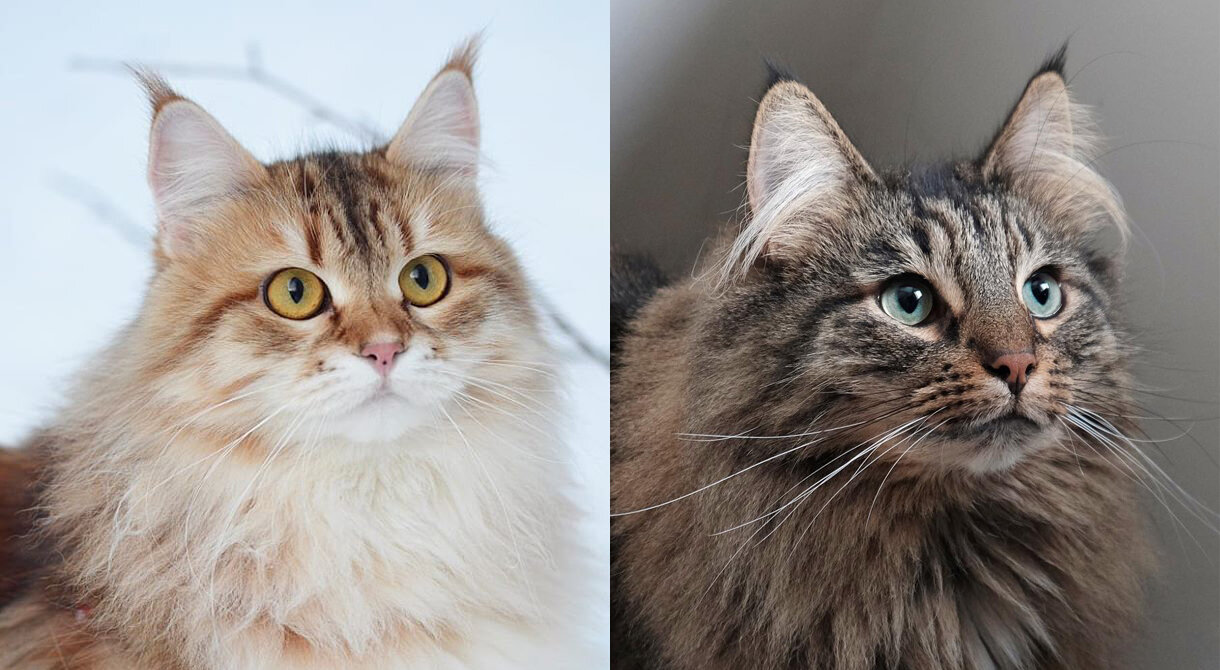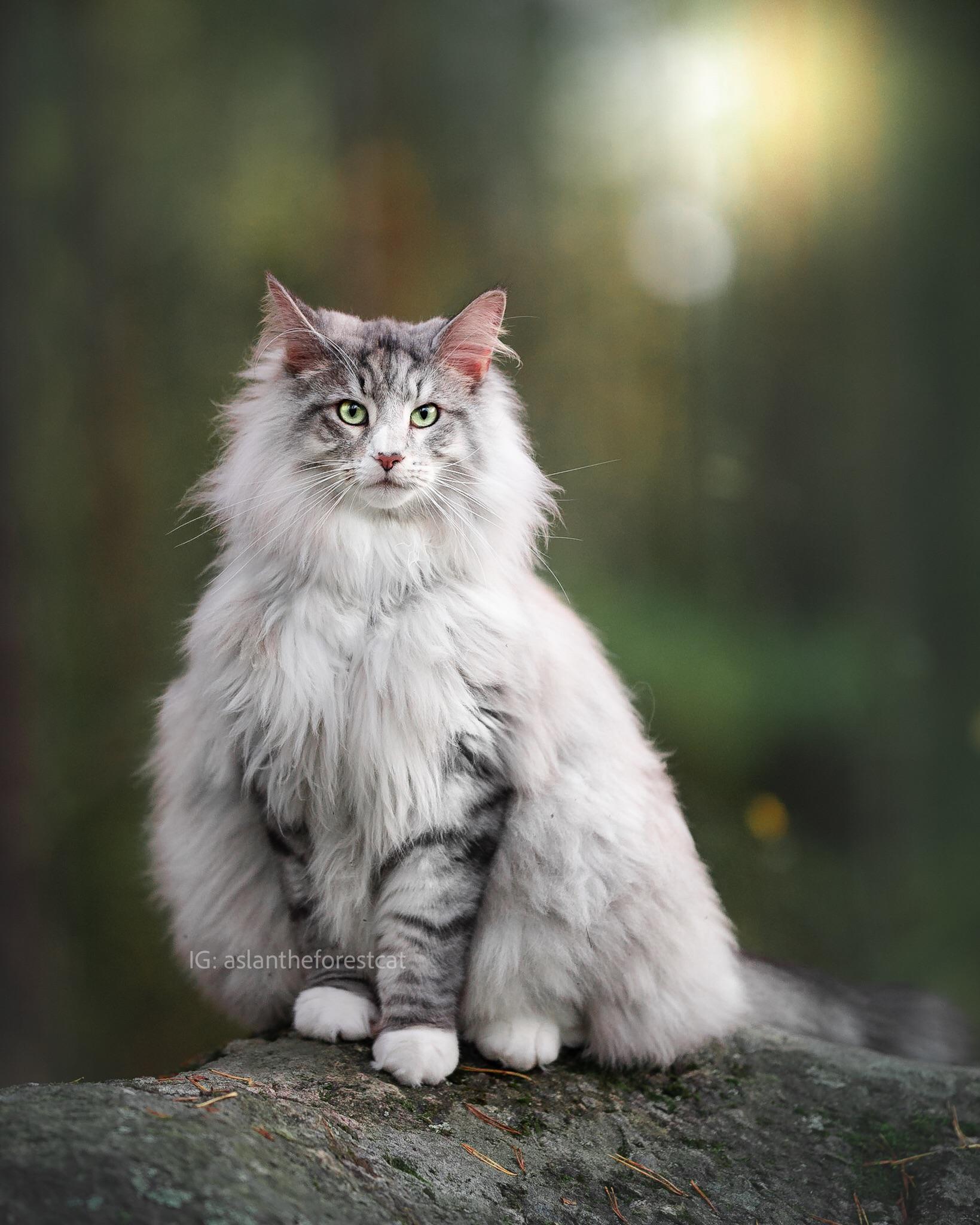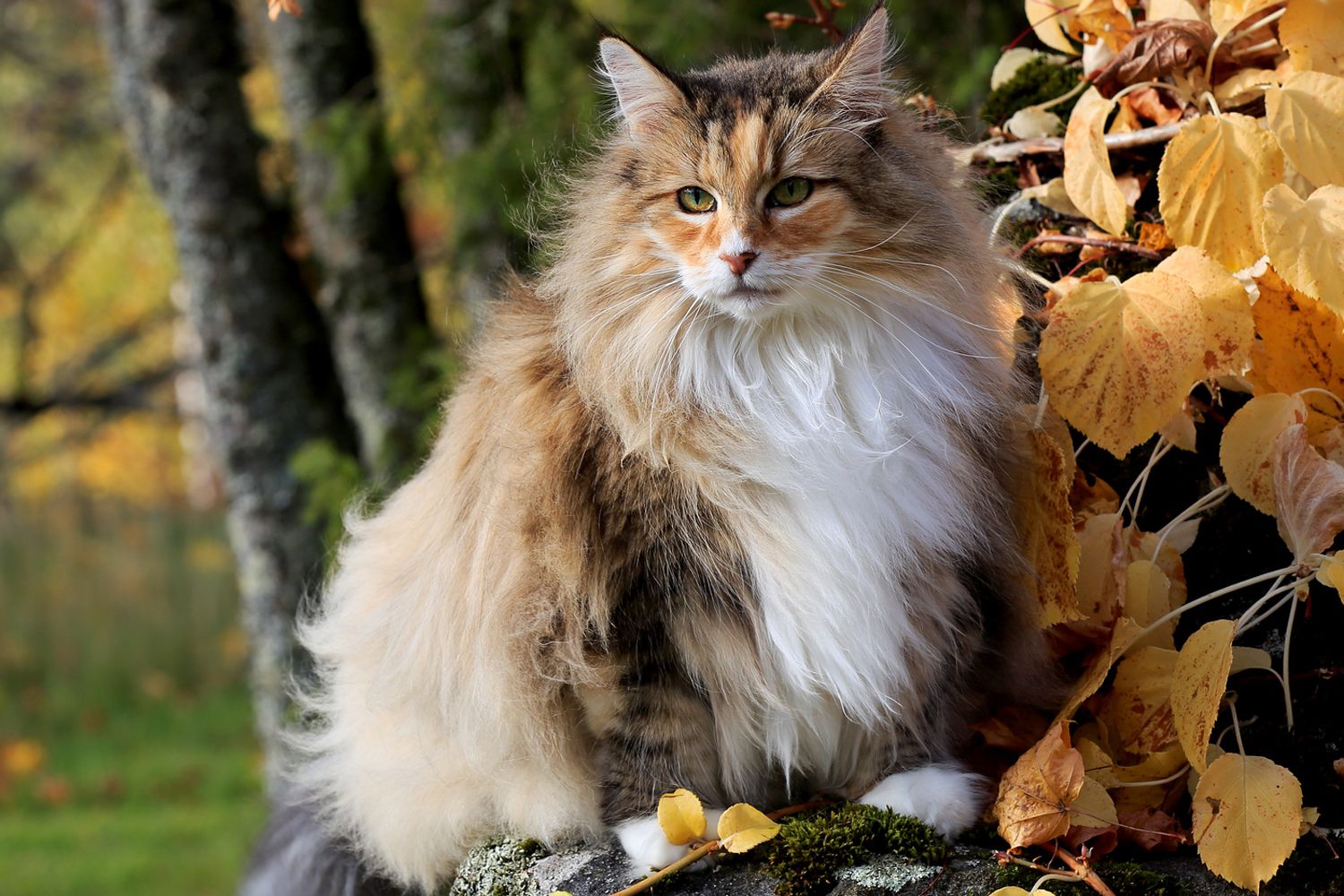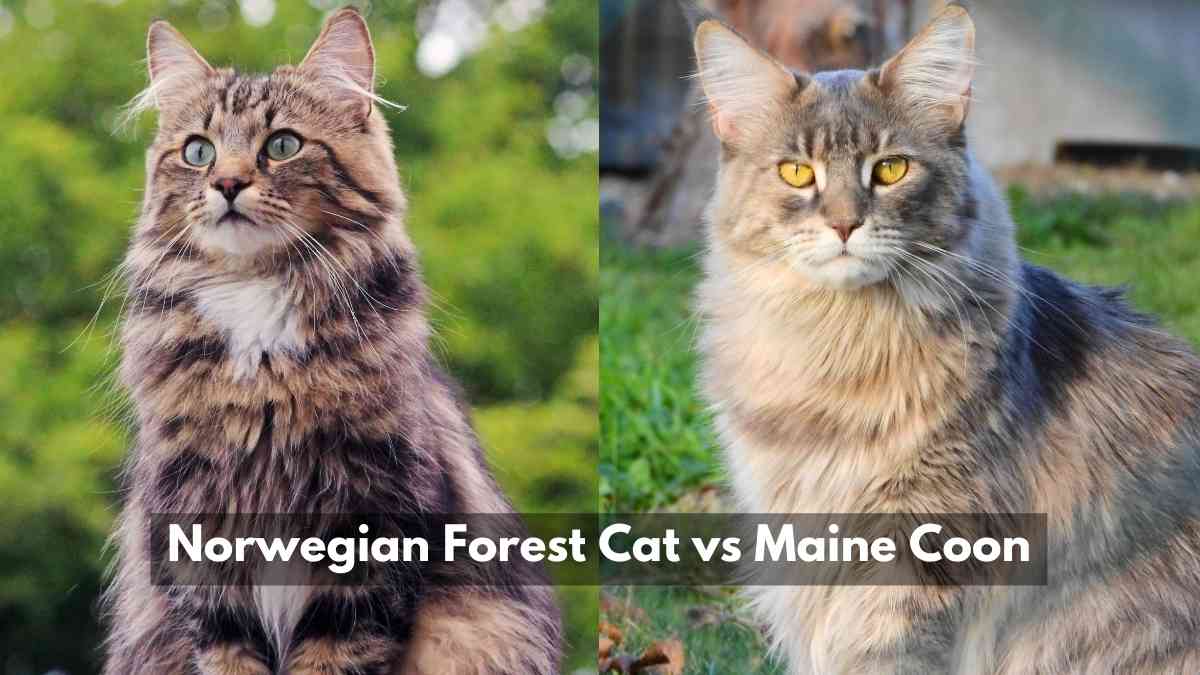The Norwegian Forest Cat is generally larger with a heavier coat than the Siberian Cat, which has a rounder body and a more distinct ruff. Both cats are cold-weather breeds with thick, water-resistant fur.
Norwegian Forest Cats and Siberian Cats both boast lush fur coats that prepare them for harsh climates. Often affectionately known as Wegies, the Norwegian Forest Cat’s origins trace back to Scandinavia, where they possibly roamed Viking ships. Characterized by their sturdy build, long hair, and almond-shaped eyes, they carry a regal aura.
In contrast, the Siberian cat, native to Russia, has a more rounded appearance and displays a charming blend of strength and agility. These majestic felines are not only a fascination for cat enthusiasts but also provide delightful companionship. Their luxuriant coats need regular grooming, which strengthens the bond between owner and pet. Adaptable and social, both breeds make excellent family pets, capturing the hearts of animal lovers worldwide.

Credit: thelittlecarnivore.com
Introduction To Norwegian Forest And Siberian Cats
Imagine a cat with lush fur and a majestic stance. Norwegian Forest Cats and Siberian Cats might just spring to mind. These two fluffy breeds have charmed cat lovers worldwide. But what sets them apart? Both the Norwegian Forest Cat and the Siberian Cat boast thick, luxurious coats, perfect for colder climates. They share a resemblance that often leads to confusion. Yet, each breed has a unique history and characteristics that cat enthusiasts adore. Let’s explore these fascinating felines further.
Origins Of Norwegian Forest Cats
The Norwegian Forest Cat, also known as ‘Wegie’, hails from Norway. Legend says they roamed the Scandinavian forests since the time of the Vikings. Their thick, waterproof coats and sturdy build helped them survive in the harsh Nordic winters. They are known for their adventurous spirit and friendly nature.
Origins Of Siberian Cats
On the other hand, Siberian Cats come from Russia. They’ve been present for at least a thousand years, thriving in Siberia’s dense forests. Siberians have a similar layered coat to the Norwegian Forest Cat, but it’s their playful and affectionate temperament that often steals the show. These cats are cherished for their ability to form strong bonds with their human companions.
Physical Characteristics
When comparing the majestic Norwegian Forest Cat to the lush Siberian Cat, certain physical features stand out. Their coats and colors set them apart. Knowing these will help in telling these fluffy breeds apart. Let’s dive into their distinct physical traits.
Coat And Color Differences
The coat of a Norwegian Forest Cat is thick and water-resistant. Its top layer is glossy, covering a woolly undercoat.
- Norwegian Forest Cats adorn a variety of colors and patterns.
- Siberian Cats showcase a similar waterproof, triple-layered coat.
- However, Siberians are often seen in earthy tones and tabby patterns.
Size And Build Comparison
Size and build offer clues to their identities. Below is a comparison table highlighting these differences:
| Feature | Norwegian Forest Cat | Siberian Cat |
|---|---|---|
| Weight | 12-16 lbs (Male) 8-12 lbs (Female) |
10-20 lbs (Male) 8-15 lbs (Female) |
| Build | Strong and muscular with long legs | Powerful and more rounded with stocky legs |
| Tail | Long and bushy | Thick and bushy |
Both breeds take pride in their large size and strong builds. Norwegian Forest Cats are often more slender compared to Siberian Cats, which are more hefty and robust.
Temperament And Behavior
Feline enthusiasts often marvel at the unique temperament and behavior of cat breeds. Distinctly noticeable in Norwegian Forest Cats and Siberian Cats, these traits contribute to their popularity. Understanding their personalities can help potential cat owners determine the perfect furry companion.
Norwegian Forest Cat Personality Traits
Known as “Wegies,” Norwegian Forest Cats boast a remarkable set of characteristics. They exude a calm and poised demeanor, often observed as gentle giants. Despite their size, they are skillful climbers, agile and graceful. Wegies are notably independent yet affectionate with family members, balancing their time between loving interactions and solitary adventures.
Adaptability is a key trait, allowing them to feel comfortable in various settings. Intelligence shines through in their keen observational skills, and they quietly assess their surroundings. Common personality traits include:
- Loyalty to their human companions
- Patient and child-friendly
- Playful but not overly demanding
Siberian Cat Behavioral Aspects
Siberian Cats are often prized for their outgoing and adventurous spirit. These cats are sociable and enjoy being the centerpiece of attention, consistently seeking interaction with humans and other pets. Their affectionate nature makes them excellent companions, eager to participate in play and cuddles.
They exhibit a wonderful balance between energy and calmness, often displaying dog-like characteristics in loyalty and playfulness. Siberians are also highly intelligent and curious, which leads to inventive play and problem-solving. Their behavioral aspects may include:
- Warm and friendly to strangers
- High level of playfulness and energy
- Capable of forming deep bonds with their owners
Adaptation To Environments
When exploring the majestic Norwegian Forest Cat and the enchanting Siberian Cat, their adaptability to different environments is truly remarkable. Both breeds hail from cold climates, where survival demands sturdy bodies and resilient spirits.
Climate Adaptability In Norwegian Forest Cats
The Norwegian Forest Cat, known affectionately as ‘Wegie,’ boasts a double-layered coat to withstand harsh climates. This coat includes a water-resistant top layer and a woolly underlayer for insulation. Originating from Norway’s icy forests, Wegies can endure extremely cold temperatures with their thick fur tailor-made for survival.
- Dense fur around the neck acts as a scarf.
- Long guard hairs repel water and snow.
- Their tufted ears and paws keep heat in and cold out.
Siberian Cats And Their Robust Nature
In contrast, Siberian Cats are the warriors of the Russian wilderness. Their adaptation to the environment is evident in their muscular build and intense agility. Siberian Cats sport a similar, lush triple-layered coat, developed to fend off not just cold, but the dampness of their habitat.
| Siberian Cat Trait | Function |
|---|---|
| Rounded paws | Act like snowshoes |
| Oily fur | Provides water resistance |
| Low sensitivity to cold | Enhances overall hardiness |
Both the Norwegian Forest and Siberian Cats exhibit incredible adaptations to their cold environments. Whether it’s the Wegie’s insulated fur or the Siberian’s robust nature, these felines are well-equipped survivors of their respective frosty realms.
Health And Lifespan
Norwegian Forest Cats and Siberian Cats share hearty ancestors, allowing them to survive in harsh climates. Today, they generally enjoy good health and a long lifespan. However, each breed has specific health issues that prospective pet parents should know.
Common Health Issues In Norwegian Forest Cats
The Norwegian Forest Cat, a breed known for its luscious fur and robust size, typically leads a healthy life up to 14-16 years. Yet, some health concerns persist.
- Hip Dysplasia: A genetic condition often leading to arthritis.
- Glycogen Storage Disease: A rare but serious disorder impacting metabolism.
- Heart Diseases: Particularly cardiomyopathy, affecting heart muscle function.
Siberian Cat Health Profile
Siberian Cats, with their round bodies and thick coats, typically enjoy a long lifespan of 12 to 15 years. This breed is known for its good health, yet some issues are more common.
| Condition | Description |
|---|---|
| Hypertrophic Cardiomyopathy | A heart condition causing thickened walls. |
| Hereditary Cancer | Some lines may have a higher risk of cancers. |
| Polycystic Kidney Disease | A genetic disorder that can lead to kidney failure. |
Breeders often screen for these conditions to ensure the healthiest kittens. Regular check-ups with a vet help keep these lovely cats in prime condition. Whichever fluffy companion one chooses, awareness and proactive care are key to a long and happy life together.
Care And Grooming Needs
Care and Grooming Needs of Norwegian Forest Cats and Siberian Cats are important due to their thick, luxurious coats. These breeds have adapted to cold climates with fur that requires regular maintenance. To keep their coats healthy and mats at bay, owners should understand the specific needs of these glorious felines.
Grooming Techniques For Dense Fur
Both the Norwegian Forest Cat and the Siberian Cat boast dense fur that demands regular grooming. Let’s dive into some effective grooming techniques:
- Brushing: Use a wide-toothed comb or a specialized brush at least twice a week.
- Detangling: Tackle mats gently with detangling sprays and tools.
- Bathing: Despite the natural water resistance of their fur, occasional baths help manage oils.
Diet And Nutrition Tips
Proper diet is crucial for these cats’ health and coat quality. Follow these nutrition tips:
| Factor | Tip |
|---|---|
| Protein | Include high-quality animal proteins in their diet. |
| Fats | Essential fatty acids are key for a shiny coat. |
| Hydration | Ensure constant access to fresh water. |
Choosing The Right Breed For You
Choosing the right cat breed can be as exciting as it is daunting. Among the fluffy felines out there, the Norwegian Forest Cat and the Siberian Cat stand out. Each breed boasts unique traits and personalities. Understanding these will help you make an informed decision that suits your lifestyle. This guide highlights what to consider and how to match these breeds with your daily routine.
Considerations For Potential Owners
Norwegian Forest Cats and Siberian Cats are sought after for their looks and charm. But they come with their own sets of needs. Before choosing, think about grooming, space, and health care. Thanks to their thick coats, expect to invest time in regular brushing. They love climbing and do best in spacious homes. Also, always plan for potential health screenings.
Lifestyle Compatibility With Each Breed
Matching a cat breed to your lifestyle ensures a joyful home for both of you. Here’s a quick glimpse at each breed’s lifestyle fit:
- Norwegian Forest Cat: Independent yet affectionate, they fit well with busy individuals.
- Siberian Cat: Sociable and hearty, great for families and those seeking a close bond.
Considering the above points will guide you to the perfect companion. The choice between a Norwegian Forest Cat and a Siberian cat comes down to your preferences and daily life. Seek a breed that brings joy and thrives in your care.

Credit: www.youtube.com

Credit: thelittlecarnivore.com
Frequently Asked Questions On What Is The Difference Between A Norwegian Forest Cat And A Siberian Cat
How Can I Tell If My Cat Is A Siberian Forest Cat?
To identify a Siberian forest cat, observe physical traits like a sturdy build, long hair, and a bushy tail. Check for water-resistant coat, rounded ears, and a heart-shaped face. Consult a breeder or veterinarian for breed confirmation.
How Do You Tell If A Cat Is A Norwegian Forest Cat?
To identify a Norwegian Forest Cat, look for a large, sturdy build, long, dense fur, tufted ears, and a bushy tail. They exhibit a triangular-shaped head, bright, almond-shaped eyes, and strong claws. Their coat is water-resistant, suitable for cold climates.
What Are The Cons Of The Norwegian Forest Cat?
Norwegian Forest Cats require regular grooming due to their thick coats. They may be prone to hereditary health issues like hip dysplasia and heart diseases. Their large size often necessitates more space and larger litter boxes. These cats can also be quite active and need plenty of exercise.
Are Norwegian Forest Cats Snuggly?
Norwegian Forest Cats often enjoy affection and can be quite snuggly with their owners. Their sociable nature makes them good companions for cuddling sessions.
Conclusion
Deciding between a Norwegian Forest Cat and a Siberian can be challenging. Each breed boasts unique features, from dense coats to playful temperaments. Whether you seek a lively companion or a gentle giant, both cats promise love and entertainment. Consider your lifestyle, space, and preferences to find your perfect feline friend.
Embrace the joys of cat ownership and cherish the distinct beauty of these majestic breeds.



